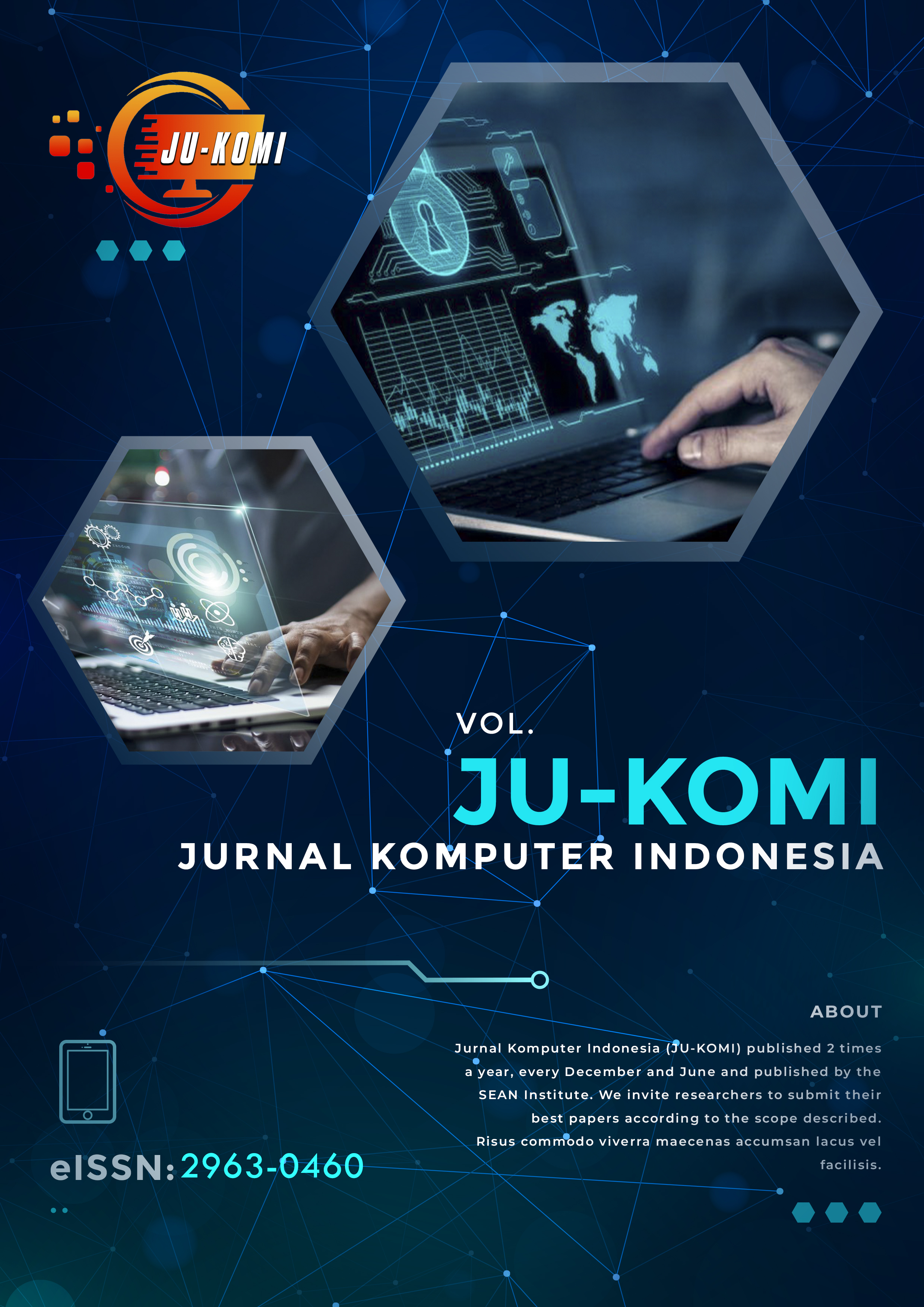Design Of Administrative Service Information System With Waterfall Method At Balohili Gomo Village Office Based On Web
DOI:
https://doi.org/10.58471/ju-komi.v1i02.334Keywords:
Administration, Public, Village, Method Waterfall, WebAbstract
The era of the industrial revolution 4.0 as it is today, there has been a rapid development in the field of technology in various countries including in Indonesia itself. The development of technology in computer networks caused a rapid increase in the field of telecommunications marked by the emergence of the internet. This technological advancement requires agencies to follow technological developments and continue to improve their ability to manage data and information. Villages as the smallest part of the administrative government system in Indosenia, are required to be able to follow technological developments and continue to improve their ability to manage population administration data. Public services in Balohili Gomo Village include all services in the village or village such as the administrative field that serves the community in making a letter or other mail carrier. There are many types of public services in the village, especially in making correspondence and other matters related to the community in a village and in its implementation it is still not neatly organized, making it difficult to find letters needed by the community. Designing an administrative information system at the Balohili Gomo Village office is one of the objectives of this study.
References
I. Basten and M. Ardhiansyah, “Perancangan Sistem Informasi Desa Berbasis Web Menggunakan Model Waterfall (Studi Kasus Desa Banjarsari Kabupaten Lebak),” 2022. [Online]. Available: http://pijarpemikiran.com/index.php/Scientia
Hutahaean, “Perancangan Sistem Web Inventory Barang,” J. Ilm. Komput. Akunt., pp. 1–20, 2015.
N. Cahyono, “Pengertian Perancangan Sistem Informasi,” 07/2015, 2015.
irwan muhammad, “No Title,” Sist. devolopmen classi.
H. Agustin, “Sistem Informasi Manajemen Menurut Prespektif Islam,” J. Tabarru’ Islam. Bank. Financ., vol. 1, no. 1, pp. 63–70, 2018, doi: 10.25299/jtb.2018.vol1(1).2045.
A. Herliana and P. M. Rasyid, “Sistem Informasi Monitoring Pengembangan Software Pada Tahap,” J. Inform., no. 1, pp. 41–50, 2016.
Sutabri, “No Title”.
A. Batinggi and B. Ahmad, “Pengertian pelayanna Umum dan Sistem Manajemen,” Modul 1, pp. 1–32, 2014, [Online]. Available: http://repository.ut.ac.id/4256/1/IPEM4429-M1.pdf
P. Andrianto, “Sistem Informasi Pelayanan Kesehatan Berbasis Web di Puskesmas,” vol. 2017, pp. 47–52, 2017.
E. A. Jaya, “Perancangan Sistem Informasi Persediaan Stock Parfum Dengan Menggunakan Bahasa Pemograman Visual Basic.Net Dan Database Access Pada Toko Gofha Perfume,” J. Sains dan Teknol. J. Keilmuan dan Apl. Teknol. Ind., vol. 16, no. 2, p. 158, 2016, doi: 10.36275/stsp.v16i2.45.
E. Sugiarto, S. Kom, and M. Kom, “Kontrak Kuliah Contex Diagram dan Data Flow Diagram Pendahuluan”.
M. L. A. Latukolan, A. Arwan, and M. T. Ananta, “Pengembangan Sistem Pemetaan Otomatis Entity Relationship Diagram Ke Dalam Database,” J. Pengemb. Teknol. Inf. dan Ilmu Komput., vol. 3, no. 4, pp. 4058–4065, 2019, [Online]. Available: http://j-ptiik.ub.ac.id/index.php/j-ptiik/article/view/5117
R. Rosaly and A. Prasetyo, “Pengertian Flowchart Beserta Fungsi dan Simbol-simbol Flowchart yang Paling Umum Digunakan,” Https://Www.Nesabamedia.Com, vol. 2, p. 2, 2019, [Online]. Available: https://www.nesabamedia.com/pengertian-flowchart/https://www.nesabamedia.com/pengertian-flowchart/
P. S. Akuntansi, F. Ekonomi, D. A. N. Bisnis, and U. M. Buana, “ANALISIS IMPLEMENTASI PENGAPLIKASIAN KONSEP BASIS DATA RELASIONAL,” no. 43220010165, 2022.
Basriya, A. Musnansyah, and E. N. Alam, “Perancangan aplikasi chi-chi thai tea berbasis website pada modul owner menggunakan metode waterfall chi chi thai tea application design website based on the owner module using the waterfall method,” eProceedings Eng., vol. 8, no. 5, pp. 9508–9519, 2021.
A. W. Anto, A. L. Noerman Syah, Y. Priatna Sari, and A. Zul Fauzi, “Desain Database Menggunakan Microsoft Access Pada Siswa-Siswi SMK PGRI Kabupaten Brebes,” ABDIMAS J. Pengabdi. Masy., vol. 3, no. 2, pp. 367–371, 2020, doi: 10.35568/abdimas.v3i2.643.
D. Puspitasari, C. Rahmad, and M. Astiningrum, “Normalisasi Tabel Pada Basisdata Relasional,” J. Pros. SENTIA | ISSN 2085-2347, vol. 8, no. 1, pp. 340–345, 2016.
G. W. Sasmito, “Penerapan Metode Waterfall Pada Desain Sistem Informasi Geografis Industri Kabupaten Tegal,” J. Inform. Pengemb. IT, vol. 2, no. 1, pp. 6–12, 2017.
P. P. (Edisi 7). Y. A. Pressman, Roger S. 2012. Rekayasa Perangkat Lunak – Buku Satu, No Title. 2012.
A. Febriani, T. Ratu, and A. H. Rahman, “Pengembangan Komik Digital Fisika Berbasis Hypertext Markup Language (HTML),” J. Chem. Inf. Model., vol. 53, no. 9, pp. 1689–1699, 2019.
A. Mubarak, “Rancang Bangun Aplikasi Web Sekolah Menggunakan Uml (Unified Modeling Language) Dan Bahasa Pemrograman Php (Php Hypertext Preprocessor) Berorientasi Objek,” JIKO (Jurnal Inform. dan Komputer), vol. 2, no. 1, pp. 19–25, 2019, doi: 10.33387/jiko.v2i1.1052.
H. T. SIHOTANG, “Sistem Informasi Pengagendaan Surat Berbasis Web Pada Pengadilan Tinggi Medan,” vol. 3, no. 1, pp. 6–9, 2019, doi: 10.31227/osf.io/bhj5q.
Panjaitan , M. I., Rajagukguk , D. M., & Manalu, M. R. (2023). Implementation of the Decision Support System for the Appointment of Permanent Employees at CV. Armas Suan Sejahatera Using the Analytical Hierarchy Process (AHP) Method. Jurnal Info Sains : Informatika Dan Sains, 13(02), 119–128.











